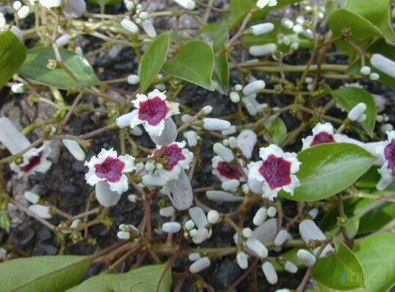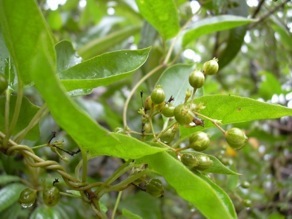Paederia foetida: Much Maligned Skunk Vine
Sometimes botanists go a little too far, or at least Carl Linnaeus did when he named a particular vine Paederia foetida (pay-DEER-ree-ah FET-uh-duh). It must have really offended him because that means, in English, stinking opals. Its common name is “skunk vine.” A close cousin, Paederia cruddasiana, found locally only in Dade County in south Florida, is called the Sewer Vine. I’m not convinced such names are deserved.
Paederia is from the Greek word paederos meaning opals, for some of the species have translucent drupes. (Some say Paederia comes from the Latin paedor meaning filth or stench, but that would be over kill and I think the Greek is more realistic, particularly in conjugating, though dirty-minded Carl was not past using double entendres.) Foetida means stinking. So stinking opals, or stinking filth, sums it up. Leaves can be eaten raw or cooked. The odor goes away on cooking but a slight bitterness remains. The leave are rich in carotine and Vitamin C.
Almost every website you go to — no, every website you go to — says it smells awful. One gets the impression one has to hold ones nose to eat it cooked, and raw it would just about make you gag. As my late father would say, “it must stink to high heavens.” The Japanese are not poetic at all about it and cut to the chase: They call it the “fart vine” the Chinese the “chicken shit” vine. I have shoveled a lot of chicken manure, and the P. foetida does not smell that bad. But to be frank the aroma is more like someone who needs a bath than someone who has bad gas. I couldn’t get much smell out of some of the leaves I collected recently until I accidently ran over one with my desk chair. I certainly had the right plant. To me it is a persistent aroma but low grade… similar to kim chee but no where near as strong… call it kim chee lite…
I think the folks who write about the plant on the internet have never met it personally. It is aromatic but there are a couple of local edibles that smell far worse, the Passafloria incarnata and the Momordica charantia come to mind. Those two smell like moldy old gym shoes that have been in a damp high school locker for a few months with some underwear. To me the P. foetida raw smells and tastes similar to raw broccoli. Indeed, both plants get their aromas from sulfur compounds, the P. foetida specifically from carbon disulphide (some say dimethyl disulfide.) I don’t find the plant offensive raw and not at all when cooked, which is a good thing because there is a lot of it.
Paederia foetida was imported from Asia by the USDA to its Brooksville Field Station in Hernando County Florida before 1897. The reason given was that it was a potential fiber plant — read wild twine when you need it. Western nations had shown an interest in Paedera’s fine fiber since at least 1873. As for Brooksville, that area of the state was ground zero for several imported Asian plants later to be troublesome. By 1916 P. foetida had become a local nuisance. You would have thought they had learned their lesson but in 1905 they imported the Dioscorea bulbifera (air potato) to Orlando and let it crawl over the state. By 1933 the Skunk Vine was escaping the region via all points north, east and south. In 1977 it was recognized as an economic problem and is now found in all southern states though the USDA official maps don’t show that. Indeed, I have located it in several places in the county I live in yet the USDA says it does not exist in my county. In fact, it grows in my yard and I didn’t plant it. I sometimes think the USDA maps are a century out of date. And, if you write and tell them the maps are inaccurate about a particular plant in return for letting them know you get a load of bureaucratic fertilizer for your efforts. I wrote extensively to one agent about a tree and he wrote back telling me to write to him about the tree… With such federal employees on the job I don’t sleep well at night.
In 1999 the state of Florida estimated it cost $4,006 per acre to remove Skunk Vine ($5,138 in 2009 dollars.) The state has tried unsuccessfully for seven years to find an importable insect to prey on the two species of Paederia it has. So far the bugs also like a trio of native plants as well so no go. The Paederia, by the way, is the host plant of the Macroglossum sitiene Walker moth. Mockingbirds like its seeds, which I think explains how it got to my yard after 10 years of not being there.
There are some 50 species of Paederia, maybe 52, eleven in south China alone. I do not know the edibility of the others. Cornucopia II says of the P. feotida: “Leaves eaten raw as a side-dish with rice, grated coconut and chili peppers. Minced leaves are steamed and eaten, added to soups, or mixed with various vegetables and spices, wrapped in a banana leaf and cooked over a fire.” I have them as cooked greens or salad additions. Since I use a lot of garlic, Paederia isn’t a noisome problem.
P. foetida is also called P. chinensis. P. scandens and P. tomentosa. In Hawaii it is called maile pilau (the rotten maile.) Other names include:
Malaysia: Akar sekentut, daun kentut, kesimbukan
English: Chinese moon creeper, Chinese fevervine, king’s tonic
Indonesia: Sembukan (Javanese), kahitutan (Sundanese), bintaos (Madurese)
Philippines: Kantutai (Tagalog), bangogan (Bikol), mabolok (Pampangan)
Cambodia: Vear phnom
Laos: Kua mak ton sua
Thailand: Kon, choh-ka-thue mue (northern), yaan phaahom (peninsular)
Vietnam: D[aa]y m[ow] l[oo]ng, d[aa]y m[ow] tr[of]n, m[ow] tam th[eer]
Green Deane’s “Itemized” Plant Profile
IDENTIFICATION: A twining vine in the coffee family. At eye level it twines from your lower right to your upper left. young stems can be green, purplish- or reddish-brown, almost hairless to densely hairy. The old stems are yellowish-brown to grayish, smooth and shiny. Leaves opposite, occasionally whorls of three, lance to oval shape, abruptly tapering point, two to four inches long, conspicuous stipules. Stipules obvate to cordate, triangular, may nor may not have two notches at top. Leaves can be hairy and non-hairy, or hairy below, smooth above, or have tuffs of hair on the underside in axils of major veins. Leaves and stems have a disagreeable odor when crushed, flowers are small, grayish pink or lilac, in broad or long, curving clusters, petals are joined to form a corolla with 5 spreading lobes. Fruits shiny yellow to brown, persists through winter, round, inside are two black seeds, round, often dotted with white, needle-shaped crystals. Seeds of the P. cruddasiana, which resembles the P. foetida, are oval, flattened and have little wings. To my knowledge the Cruddasiana is not edible.
TIME OF YEAR: Year round
ENVIRONMENT: Disturbed areas, tree gaps, may grow high into the trees creating dense canopies in a variety of habitats, mesic hammocks to xeric sand hill communities, prefers sunny flood plains and bottomlands, can even grow under water. Found in the southern United States, Hawaii, and as an escaped ornamental in warm areas of the world.
METHOD OF PREPARATION: Leaves raw or cooked. The plant can be killed by chemicals so don’t collect where it might be sprayed such as along railroads, roads, bike paths or powerlines. It is used to make soups, is minced in steamed food.
HERB BLURB
Long used in Indian folk medicine for aches and pains, a 2004 study in Bangladesh showed it has analgesic properties. Nutritionally, besides, carotine and vitamin C, the P. foetida contains nonanoic acid, capric acid, lauric acid, myristic acid, arachidic acid, palmitic acid,conjugated dienoic acid and trieonic acid. It also has antioxidant activity. A 2005 study also showed it was good for lessening the symptoms of diarrhea. Traditionally it was used to treat dysentery but a 1991 study showed antibiotics worked better. Leaf juice mixed with garlic is a folk remedy for arthritis. Juice of the root is given for indigestion.




Having spent 13 months as a GI in Korea in the late sixties, I really do not know what variety of Kim Chee to which you are referring. If one of the Korean soldiers started heating up kim chee in our hooch (quonset hut), ALL GIs would evacuate.
I don’t know if your sense of smell is compromised or we’re not on the same page but the skunk vine in my yard stinks to high heaven. Its so bad I find myself wondering if it’s a defense mechanism that can actually make you sick. It’s stinks enough to be sickening.
Of course it smells, which is why it is called Skunk Vine. Broccoli smells, too. I think the chemical class one smells is Sulforaphanes, which are extremely good for you.
Wow! Now that is some news! Hearing the scent described like that really does make sense though. The similarities to broccoli and the cruciferous vegetables makes me wonder if the house will smell when you cook it as well? I live in Hernando County, the “hot spot” so there’s plenty around! Now I just have to get the nerve up to try it! Thanks for the info! It’s ALWAYS good to know another wild edible!(especially when it’s so plentiful!) Love your work btw! Your my Wild Edibles “Hero”! Ha ha
Yes, cook outside if possible…
It has taken over my backyard including my jasmine plant, my elderberry tree & my lemon tree. The mocking bird thing makes sense as to how it got there. Can I contain it? I would like to try using it.
Hello there! I am looking for Paederia foetida (skunkvine) plant. I live at Sunshine, Melbourne.
Thanks for the info, I was hoping the vine in my front yard was skunk vine, but it’s not.
Where in Florida are you?
Orlando.
We have two of these growing in the yard of the home we just bought in Citrus County. I second your opinion that it really isn’t very smelly at all. In fact, the flowers have a very mild pleasant smell. Or maybe I’m crazy. It took me forever to identify it because my ap kept calling it “onion vine”. Have you heard of this name for it?
You might not want to publish my last comment. Turns out what I have is a skunk vine growing through a confederate jasmine. That’s why it smells so nice. LOL
Now, that is funny!
I’d love to get some from you. Not to grow, but because I’ve been drying, boiling and drinking the stems for a couple years now as a healing medicine for ulcerative colitis. I finally discovered what it is called here in the states. My step mom has been mailing me the dried vine from Vietnam (called Thui ditch) but it costs so much to ship a package here. I live in Louisiana now, so even wondering if I can find it growing here? Here’s a article on it’s use in Vietnam. https://ntfp.org/2009/03/mountain-medicine-man-phong-of-nui-chua-national-park-2/